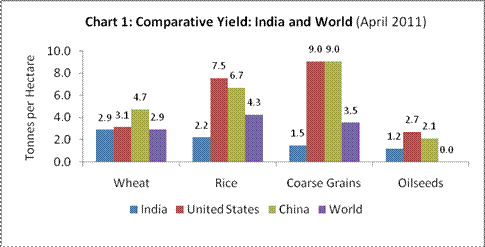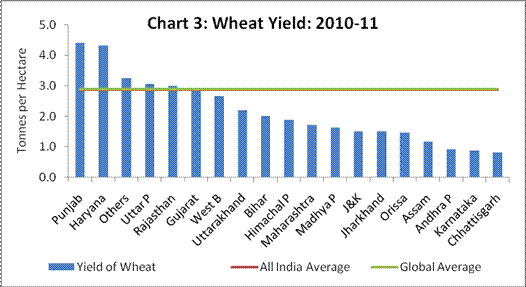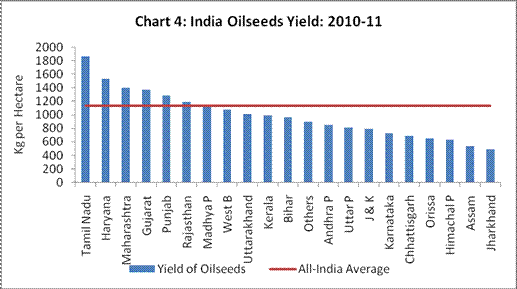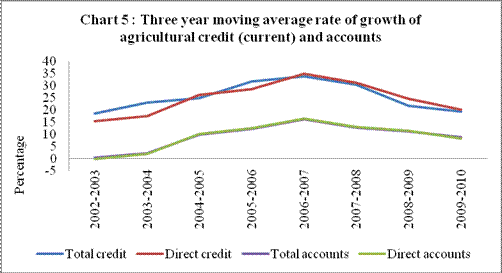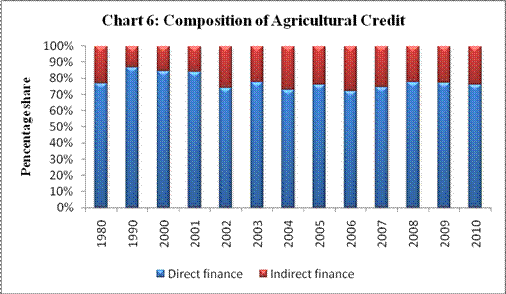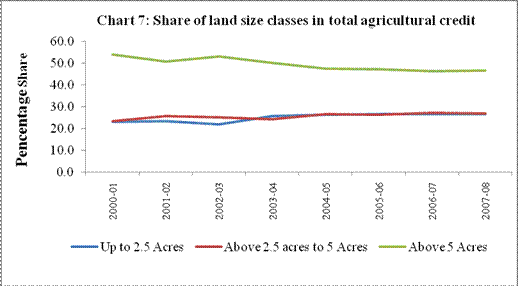 IST,
IST,


Agricultural Productivity and Credit- Issues and Way Forward
Dr. K.C. Chakrabarty, Deputy Governor, Reserve Bank of India
delivered-on ਸਤੰ 02, 2011
Prof. M. S. Swaminathan, Shri A. S. Bhattacharya, CMD, Bank of Maharashtra, Ms Kamala Rajan, Principal, CAB, Shri R. L. Sharma, Vice-Principal, CAB and other members of faculty, distinguished panelists, participants, ladies and gentlemen! It is a pleasure to be here this morning for the “National Seminar on Productivity in Indian Agriculture” organized by CAB, Pune. 2. In the Indian context, the policy of self-sufficiency in food which led to Green Revolution had served the country well. The country currently has sufficient stocks of wheat and rice which are above buffer stock norms and food security reserve requirements. However, in the medium to long term, concern over food security is likely to become more intense. This is because land is scarce and its supply is limited. Further, sustained dependence on food imports is not an option that is viable in Indian context. Therefore, food safety net for the present and future population requires enhanced agricultural production and productivity. This is already attracting the attention of the Reserve Bank of India. Thus, this Seminar organized by CAB, Pune is very topical and the theme has great bearing on the future growth of India. 3. And who could be a better person than Prof. M. S. Swaminathan to set the tone for this Seminar. It is indeed a matter of great privilege that Prof. M. S. Swaminathan is in our midst today. Known as the "Father of the Green Revolution in India" for his leadership and success in introducing and further developing high-yielding varieties of wheat in India, his vision is to rid the world of hunger and poverty. Prof. Swaminathan is an advocate of moving India to sustainable development, especially using environmentally sustainable agriculture, sustainable food security and the preservation of biodiversity, which he calls an "evergreen revolution”. He has worked worldwide in collaboration with colleagues and students on a wide range of problems in basic and applied plant breeding, agricultural research and development and the conservation of natural resources. It was only in the fitness of things that he delivered the inaugural address today. Sir, we are overwhelmed by your insightful address and I am sure all of us have immensely benefited listening to his valuable views on a subject which is not only very dear to you but also so vital for the country’s economic growth. 4. I also note that the Seminar includes several eminent speakers with vast experience on the subject. There are sessions on agricultural productivity, role of research and technology in improving agricultural productivity, linkages between productivity and farm income, incentivizing productivity enhancing investments, relation between credit growth and productivity growth and mitigation of risks in agriculture. In my address today, coming as do from the RBI, I would broadly focus on major trends/issues in agricultural productivity and credit, and the role of agricultural credit in improving agricultural productivity. I would also touch upon some of the steps that can yield results in the short-term. Importance of agriculture 5. As you are aware, the recent Indian growth story has been service-led. Services sector has completely replaced agriculture, which was traditionally the largest contributor to India’s GDP. However, the fact that agriculture has the smallest share in GDP of only about 14 per cent today from a high of more than 50 per cent , does not belittle its importance for the Indian economy. This is because first, as we all know, agriculture remains the largest employer having a share of around 60 per cent. Secondly, it holds the key to creation of demand in other sectors and remains by far an important indirect contributor to India’s GDP growth. The agriculture sector needs to grow at least by 4 per cent for the economy to grow at 9 per cent. Thus, though having a small share, the fluctuations in agricultural production can have large and significant impact on overall GDP growth. Thirdly, since food is an important component in basket of commodities used for measuring consumer price indices, it is necessary that food prices are maintained at reasonable levels to ensure food security, especially for the deprived sections of our society. In fact, food security is emerging as an important policy concern, and the role of agriculture in ensuring equitable access to food has added a new perspective for policy makers. Trends in Agricultural Productivity 6. I would like to discuss certain trends in agricultural productivity in India. As is well-known, the year 1968 marked the beginning of a turning point in Indian agriculture. The country was dependent on agricultural imports for almost two decades after independence. Production of rice and wheat grew at 28.0 per cent and 23.6 per cent, respectively, during 1967-68 while their yields during the same year grew at 19.6 per cent and 24.4 percent, respectively. This was the first time that such high growth in production and yield of both rice and wheat was witnessed in the country. These levels of growth remain one of the highest achieved so far. The development of high-yielding variety (HYV) of seeds in mid 1960s and the subsequent use of the fertiliser-pesticides-irrigation package, better seeds, improved irrigation and education of farmers led to quantum jumps in the productivity. Consequently, production of wheat, rice and foodgrains grew at an average rate of 21.9 per cent, 10.3 per cent and 10.9 per cent, respectively, during the subsequent years 1967-1970. This may be attributed to significant rise in yield of wheat, rice and foodgrains which grew at an average rate of 11.2 per cent, 7.9 per cent and 8.1 per cent, respectively, during the same years. These growth rates have also been unprecedented. High growth in production and yield continued during the subsequent decades of 1970s and 1980s. Production of wheat, rice and foodgrains during 1970s-1980s grew at an average rate of 5.1 per cent, 4.0 per cent and 3.3 per cent, respectively. The yields of wheat, rice and foodgrains grew at an average rate of 3.1 per cent for wheat and rice, and 2.9 per cent for foodgrains, respectively, during the same period. These rates of growth in production and yield were much higher than the average annual rate of growth of population of 2.2 per cent during the same period. This enabled the country to achieve self-sufficiency in terms of wheat and rice (Table 1). 7. The productivity of Indian agriculture, however, witnessed a fatigue with the average growth rate of production of wheat, rice and foodgrains during 1990-2010 coming down to 2.6 per cent, 1.4 per cent and 1.6 per cent, respectively. This was due to stagnancy in yield of wheat, rice and foodgrains which grew at an average rate of 1.7 per cent, 1.2 per cent and 1.6 per cent, respectively, during the same period. Moreover, the average growth rate of foodgrains production at 1.6 per cent during 1990-2010 trailed the average population growth of 1.9 per cent (Table 1). As a result, the per capita net availability of foodgrains per day came down from 510.1 grams in 1991 to 444.0 grams in 2009. The corresponding figures for pulses were 41.6 grams and 37.0 grams, respectively. 8. Low yield per unit area across major crops has become a regular feature of Indian agriculture in recent years. This can be attributed to structural weaknesses of the agriculture sector reflected in low level of public investment, exhaustion of the yield potential of new high yielding varieties of wheat and rice, unbalanced fertiliser use, low seed replacement rate, an inadequate incentive system and post harvest value addition. Some of the other reasons that can be attributed to the low agricultural productivity in our country are (i) Lack of irrigation facilities in major part of the cultivated land; (ii) Small and fragmented land holding with the cultivators; (iii) Lack of timely availability of quality seeds, fertilizers for providing all major and minor nutrients for the crops and insecticides in many parts of the country; (iv) Lesser availability of photo period as compared to countries like those in Mediterranean sea areas. 9. Productivity of Indian agriculture is low as compared to the productivity at the global level. Estimates of yield of rice as of April 2011 in India was 3.2 tonnes per hectare as against 7.5 tonnes per hectare in the United States, 6.7 tonnes per hectare in China and an average of 4.3 tonnes per hectare for the world (Chart 1). Similar contrast in yields have also been observed in case of wheat and coarse cereals though yield gaps as regard oilseeds were lesser i.e., 1.0 tonne per hectare, 2.7 tonnes per hectare and 2.1 tonnes per hectare for India, United States and China respectively. Even the most productive States in the country fall short of world standards in terms of yields of major crops.
10. During 2010-11, Punjab with the highest yield in rice produced 3.8 tonnes per hectare as against the world average of 4.3 tonnes per hectare. Yield of oilseeds in Tamil Nadu, the highest in India, at 2.1 tonnes per hectare was lower than 2.7 tonnes per hectare in China and United States. However, yield of wheat at 4.5 tonnes per hectare in Punjab during 2010-11 is higher than that of the United States and the world average though it was marginally lower than 4.7 tonnes per hectare in China. Further, there exists a wide variation in productivity of these crops across States/regions in India (Charts 2-4). There is an urgent need to address inter-regional, inter-State and intra-State disparities in agricultural productivity.
11. There is also a need to emphasize on increasing productivity of millets such as Jowar and Bajra. The productivity of other crops such as oilseeds, pulses, and horticulture also needs to be improved. Shortfall between demand and supply of key food items like milk and eggs is likely to occur which needs to be addressed. According to National Dairy Development Board (NDDB), India would need 180 million tonnes of milk by 2021-22. This would effectively mean that the current addition to annual production of milk which is 2.5 million tonnes at present must be doubled to 5 million tonnes per year to achieve self sufficiency in 2021-22. Likewise, National Institute of Nutrition has recommended 11 kg of meat and 180 eggs per capita consumption for our country, whereas the per capita availability of meat is just 1.6 kg and per capita availability of eggs is 42. As per the Eleventh Five Year Plan, demand-supply gap during 2009-10 with respect to oilseeds is estimated to be around 13.4 per cent in oilseeds, 18.7 per cent in pulses and 2.0 per cent in foodgrains. Estimates by the Indian Council of Agricultural Research (ICAR) show that in order to meet demand requirements of food items like oilseeds, fish, eggs and fruits by 2020-21, production have to grow at an annual rate of 6.0 per cent, 3.5 per cent, 3.4 per cent and 2.9 per cent, respectively, for the period of 15 years i.e., during 2006-07 to 2020-21 (Table 2). Therefore, a meaningful and comprehensive analysis of productivity of all segments of agriculture is needed for effective policy intervention. Also, creation of opportunities and efforts to shift workforce engaged in agriculture sector to agro-industries and agro-services to increase employment would have to be made.
12. In recent years, yields of crops have remained low and there has been a progressive hike in minimum support price (MSP) for wheat and rice. This may be seen as a continuation of policy tilt in favour of price intervention as against non-price intervention followed in the post-reform years. This has ensured sufficient and steady procurement of foodgrains which can cater to meet the demand of the public distribution system (PDS) and various welfare schemes of the Government. However, for various reasons, off-take of foodgrains has not kept pace with procurement. 13. Skewed incentives as regard rice and wheat have affected land use and cropping pattern with public procurement remaining concentrated in a few States. Currently in most States, the MSP is a purely a notional price as far as farmers are concerned. Farmers know that they have an option to sell their produce at MSP but they have no access to Government granaries or take-in windows. 14. Lower off-take, despite adoption of the Decentralized Procurement Scheme (DCP) under which foodgrains are procured and distributed by the State itself , combined with higher procurement has resulted in large stocks of foodgrains, which are often higher than the required buffer norms and food security reserves. In the past three decades, except for a few years, aggregate procurement of rice and wheat has been higher than their off-take. 15. To sum up, Indian agricultural situation today, therefore, is a mix of declining yields, low productivity, inter and intra-state and regional disparities, skewed incentives and inappropriate food stock management in the backdrop of increasing concerns on food security and food price volatility. In this context, a frequent refrain is that credit is not available. While empirically this is not the case, let me ask you all whether credit is an important component of raising productivity? If yes, then do we know the direction of credit? Can credit alone solve all the problems of declining or low agricultural productivity and how, after all, do we improve productivity? I would like to focus on major trends in agricultural credit and its role in improving productivity. Trends in Agricultural Finance 16. In India, where the formal financial system is predominantly bank-oriented, banks play an important role in financing the needs of agricultural sector. With the aim of facilitating the timely and adequate credit flow to agriculture, the sector has been targeted as a part of the priority sector lending programme introduced after nationalisation of banks in 1969. Domestic commercial banks have been directed to allocate 18 per cent of net bank credit to agriculture and allied activities. The directed credit programme has clearly resulted in a significant increase in the amount of credit allocated to agriculture over the years (Table 3). Moreover, the Government of India also directed commercial banks, RRBs and cooperatives to double the flow of agricultural credit over a span of three years since 2004. Further, the scheme of interest rate subvention was introduced by the since 2006.
17. Growth in agricultural credit and number of accounts, which was on a declining trend during 1990-2000 has picked up in early 2000s and continued till 2006-07, but is again showing a declining trend in the recent years (Chart 5). During the period of high growth in agricultural credit, the share of indirect credit was on an increase (Chart 6) but has remained stagnant in subsequent years. Moreover, the share of small and marginal farmers in total credit, which was at about 27 per cent each, stayed unchanged at that level between 2004-05 and 2006-07, even as agricultural credit growth was on a rise (Chart 7). This clearly meant that the benefits of doubling of agricultural credit to small and marginal farmers have been relatively less.
18. It has also been observed from available data that the share of total agricultural credit supplied through rural branches has seen a decline from 55.5 per cent in 1990 to 38.5 per cent in 2010 (Table 4). The contribution of urban and metropolitan branches to agricultural credit has increased from 14.9 per cent to 33.7 per cent during this period, indicating that credit disbursement is mainly through non-rural branches. The available data raises questions about the segments to which the credit is actually flowing and whether it is reaching the intended beneficiaries.
Non-Availability of relevant MIS 19. The analysis of flow of agricultural credit and its impact on productivity is constrained by the absence of granular data other than total, direct and indirect credit. Further, there is limited data on agricultural credit to various crops, horticulture and allied activities even on a consolidated basis. The dearth in the availability of granular and disaggregated data greatly hampers policy making. For instance, banking system at present does not capture data on finance to agriculture sector other than total credit, direct and indirect credit. There is also great confusion among banks in the figures relating to credit disbursed and credit outstanding. The number of beneficiary accounts is not under focus. There is no systematic segmentation of data among Scheduled Commercial Banks/ Regional Rural Banks/State Co-operative Banks/District Central Cooperative Banks. Recommendations for improving agricultural productivity 20. This brings me to my last section on what are the challenges in improving productivity and in what way these challenges can be overcome. 21. The major challenge in this regard is that nearly 80 per cent of the land holdings in India are below 2 hectares in size. Unless factor productivity is increased, small farm agriculture will become un-remunerative. However, the smaller the farm, the greater is the need for marketable surplus in order to get cash income. Therefore, improving small farm productivity, as a single development strategy, can make the greatest contribution to the elimination of hunger and poverty. The wide differential in productivity across States and the fact that agriculture is a State subject itself poses a challenge. Slow rate of infrastructural development hampers physical connectivity, marketing and information dissemination across all regions uniformly which acts as a bottleneck in improving productivity. 22. Hence, the following suggestions/approach may be deliberated by the participants of this Seminar:
Conclusion 23. This is not an exhaustive list. However, I feel that instead of lamenting that productivity has been low, we must look at the past to the Green Revolution in the 1960s to draw confidence that productivity can be improved. We need to find ways to surmount the existing constraints and step up productivity using finance as a tool. The Green Revolution paved the way for food security in India. No major technological breakthrough has emerged since then, and with the need for higher production growing, a second green revolution is inevitable. In fact, to borrow a term coined by Prof Swaminathan, we need an evergreen revolution. However, to cater to the food security and food safety net, India needs a higher production along with enhanced productivity in cereals, pulses, oilseeds, vegetables, poultry, meat, fish and milk. I am sure the Seminar would be very useful in generating new ways and means to do so. To achieve this goal, India needs to invest more in agriculture and allied sectors. I wish the deliberations of the Seminar a success and hope that an actionable plan would emerge out of it and the participants would take it upon themselves to implement it in their respective organizations so that regional and inter and intra-State disparities can be narrowed down and we can effectively contribute to increasing agricultural productivity in our country. 1Address by Dr. K. C. Chakrabarty, Deputy Governor, Reserve Bank of India at The National Seminar on Productivity in Indian Agriculture at CAB, Pune on Sep 2, 2011. Assistance provided by Shri Thanzason Sonna and Smt Pallavi Chavan in preparation of this address is gratefully acknowledged. |
||||||||||||||||||||||||||||||||||||||||||||||||||||||||||||||||||||||||||||||||||||||||||||||||||||||||||||||||||||||||||||||||||||||||||||||||||||||||||||||||||||||||||||||||||||||||||||||||||||||||||||||||||







